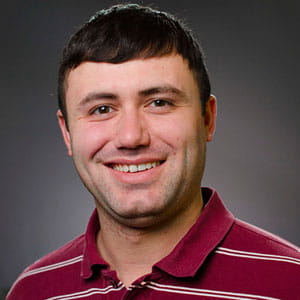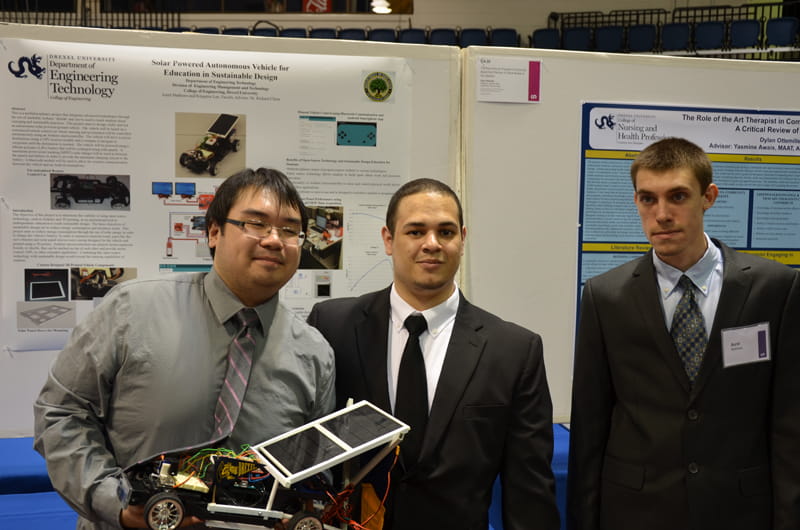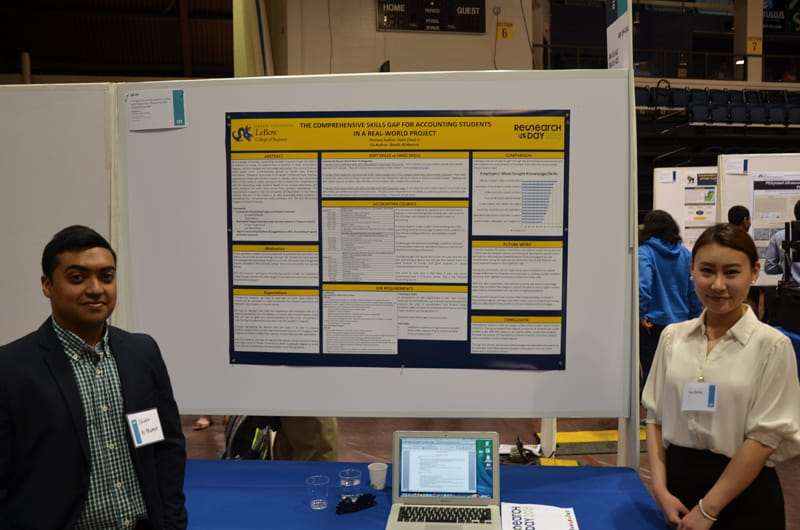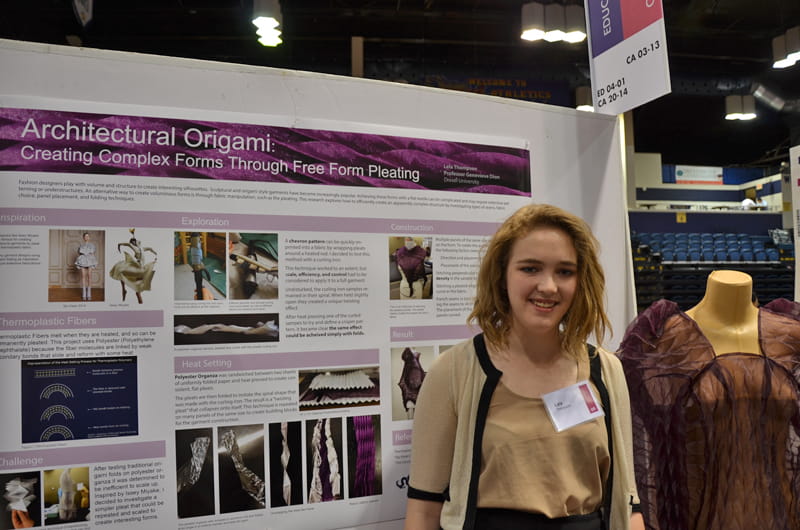Research Day 2015 Highlights Impactful Student Projects
 By Frank Otto
By Frank Otto

- Bolstered by Research Consortium with Drexel, Jefferson’s Sidney Kimmel Cancer Center Earns NCI Comprehensive Cancer Center Designation
- Alyssa Kemp Named as 2024 Truman Scholar
- Faculty Highlights: Recent Awards and Grants
- Ribbon-Cutting Ceremony Marks Official Unveiling of Drexel Station at 30th Street
Sometimes, the crowd around posters became so large with judges and interested onlookers that it was tough to move through the aisles.
“Where should we go next?” one student smiled to his friend early Friday afternoon, scanning the temporary aisles filled with posters.
“Let’s check out Translational Research,” she cheerily replied after checking a directory near her.
Such was the scene at Drexel’s annual Research Day, held on the basketball court at the Daskalakis Athletic Center Friday. Approximately 240 research projects were presented in poster form to judges as well as any interested faculty, staff and students. The projects covered nine different categories and were culled from a pool of 372 applicants.
“I feel privileged to see all our community, ranging from biomedical engineering to environmental science,” said Fareed Cheema, a student from the College of Medicine who was presenting on his findings on plastic surgery in children. “There are a lot of great projects here.”
Mike, Mike, Mike, Mike. Guess what day it is?! #ResearchDay2015 pic.twitter.com/68pEjkkpmK
— Drexel Research (@DrexelResearch) May 1, 2015
MaryAnn Skedzielewski, executive assistant in Drexel Research, put together the event Friday that celebrated the innovation and creativity of the University’s student researchers.
“We’ve had a good turnout with students and also our judges have done a good job coming in and helping out,” she said.
Drexel Research Day 2015 in all its glory. #DUResearchDay @DrexelResearch pic.twitter.com/D5W0yJ9gBp
— DrexelNow (@DrexelNow) May 1, 2015
Skedzielewski said this year’s Research Day was scaled back slightly because of the available space, but she feels it made students who applied more invested and competitive.
“The judges are all very impressed and happy,” she said.
Here are a few of the projects that were presented Friday:

"Remotely Accessible Laser Scanner Prototype to Study Solar Cells Defects"
By Pranav Ram Kamarajugadda and Chetana Bayas, College of Engineering
Project Summary: A portable, low-cost laser scanner prototype that can quickly and efficiently detect “granular” defects in solar cells by measuring current and providing a visualization through data.
Potential Impact: The intention is to do the scanning remotely and make the data readily available. “This model can be used by students to learn more about defects in solar cells.” — Kamarajugadda
A look at pitch pitches thrown by MLB players and elbow injuries #DUResearchDay pic.twitter.com/al4hMwnVcl
— DrexelNow (@DrexelNow) May 1, 2015

"Solar Powered Autonomous Vehicle for Education in Sustainable Design"
By Aurel Mathews, Kingston Lee and Carlos Ruiz, College of Engineering
Project Summary: A remote-controlled car powered by Arduino solar energy shields that can be pre-programmed to head to points using a compass and GPS technology. The car will be used for teaching students about sustainability.
Potential Impact: “We hope that it could be integrated into a college course and teach students about different technologies in sustainable design.” — Mathews
Another presenter talking a vinegar carbonated beverage that is healthier than soda #DUResearchDay pic.twitter.com/MQEKVUaVdV
— DrexelNow (@DrexelNow) May 1, 2015

"Self-Management Strategies for Monitoring Fluid Intake in Heart Failure Patients: A Literature Review"
By Zachary Hathaway and Rose Ann DiMaria-Ghalili, College of Nursing and Health Professions
Project Summary: An exploration of methods and techniques for managing food restrictions and fluid intake to help patients suffering from heart failure prevent malnutrition.
Potential Impact: “Eventually we hope to sort of create more strict guidelines and rules for regulating nutrition for these patients. Right now, we have very little understanding of how patients are monitoring their food intake and how their nurses are monitoring it. You want to create a sort of standardized guideline.” — Hathaway
Presenting our porosity based model to detect #SickleCell at #DrexelUniversityResearchDay @DrexelResearch pic.twitter.com/XiMs3vkQVv
— Christopher Brown (@logBase10) May 1, 2015

"The Comprehensive Skills Gap for Accounting Students in a Real-World Project"
By Dori (Yue) Li and Shaikh Al Mamun, LeBow College of Business
Project Summary: A deep look into what skills today’s accountants in top firms look for in students and what schools could be doing to better equip their accounting majors for the job market.
Potential Impact: “There are skills that are not being taught that students are not aware of. We’re trying to make students and faculty aware when they design courses, there are certain skills that stick out for applicants in requirements … We want students practicing these skills and learning them for graduation.” — Al Mamun
Joseph Batte of the College if Med explains his project #DUResearchDay pic.twitter.com/unL0Xw6XMi
— DrexelNow (@DrexelNow) May 1, 2015
– The Winners –
Although Research Day highlighted a plethora of highly innovative and interesting research, the judges were ultimately tasked with deciding what the best projects were.
Each judge went through as many presentations as they wished and received personal presentations from the student researchers.
“I think it’s really great for students to have to explain for a stranger,” said Christina Love, PhD, an assistant teaching professor of physics who also served as a judge Friday. “It will have a good impact on their future when they’re looking to continue their education or get a job. You ask them questions they wouldn’t think of and they realize, ‘Oh, I need an answer for that.’”
Here are the presentations that were judged to be the best of the best:
Undergraduates
- Bio and Biomedical — “PEGylated Ultrasound Contrast Agents for Drug Delivery to Pancreatic Tumor Cells” by Stephen Zachariah
- Business Research — “Sensory Study of Ready-to-Eat Meats with Natural Antimicrobials” by Shannon Bonelli

- Computation and Modeling (Non-Bio) — “Product Development and Sensory Evaluation of Novel Sparkling Vinegar Beverage, A Healthier Option for Carbonated Beverages” by Jericho Turingan
- Creative Arts & Design — “Architectural Origami: Creating Complex Forms Through Free Form Pleating” by Lela Thompson
- Education and Outreach — “Study of Primary Students’ Calculation Ability in USA and China” by Junjing Zhang
- Humanities & Social Sciences — “Who Teaches Us What’s Right — Can Virtue be Taught in a Classroom Setting?” by Sarah Margulis

- Physical Science & Engineering — “Identifying Affordable Rain Gauges for Green Stormwater Infrastructure Research” by Mehar Kalra
- Translational and Clinical — “DNA Isolation for Performance at Point-of-Care Using a Smartphone-Enabled Real-Time Polymerase Chain Reaction (PT-PCR)” by Chris Cox
Graduates
- Bio and Biomedical — (Tie) “Measuring Thermal Physiology to Predict Animal Responses to Directional Climate Change” by Kaitlin Baudier; “Behavioral Variation in Prey Odor Responses in Northern Pine Snake Neonates and Adults” by Kevin Smith

- Business Research — “The Effect of Advertising Models’ Body Size on Consumers’ Perceptions of Self and the Ad” by Hoori Rafieian
- Computation and Bio-Modeling — (Tie) “Differentiating Neural Distributions: How Neural Geometries Can Impact Neural Firing Dynamics” by Maxwell Henderson; “Prokaryotic Nucleotide Composition is Shaped by Both Phylogeny and the Environment” by Erin Reichenberger; “A Computational Study of Amyloid ß-Protein Assembly in Crowded Environments” by Matthew Voelker
- Computation and Modeling (Non-Bio) — “Evolution of a Metadata Application Profile for a Digital Data Repository” by Edward Krause

- Creative Arts & Design — “A Creative Approach to Artificial Intelligence; Engaging Ethics, Empathy and Speculative Design” by Jay Hardman and Elena Sabinson
- Education and Outreach — “Integrating Health Education” by Evan Gooberman
- Humanities & Social Sciences — (Tie) “Depression, Stress and Health Behaviors Among Mothers in the Neonatal Intensive Care Unit” by Lauren Deruyter; “Identifying Women’s Occupational Patterns in a Long-Term National Health Study” by Aimee Palumbo
- Physical Science & Engineering — “Todorokite Manganese Oxide as a Li-ion and Na-ion Battery Intercalation Host” by Bryan Byles
- Translational and Clinical — “The Effect of Maternal Obesity on Birth Weight: A Retrospective Cohort Study” by Roxanna Irani
– Beyond Research Day –
Drexel’s Research Day doesn’t just end around 3:30 p.m. Friday.
The projects presented are designed to live on and make positive changes. One of the main goals, Skedzielewski said, was to foster collaborations and interdisciplinary projects.

Love said a group of students presented on a project for which they planned improvements to a local playground as well as adding elements of solar power.
“I think the interdisciplinary, community-based research is the best,” she said.
Physics Professor Dave Goldberg, who served as a judge Friday and also had some students who were presenting, was impressed by what he saw.
“I saw one where they’re working on software to basically interpret signals from the head from people who are totally locked-in from things like ALS,” Goldberg said. “Very, very high impact.”
Another student’s presentation use applied mathematics to look into mirrors for vehicles that provide a better field of view and reduce blind spots.
“These are not just hooking up your potato to light up your light bulb,” Goldberg said. “This is really innovative science that is also really impactful.”
Drexel News is produced by
University Marketing and Communications.